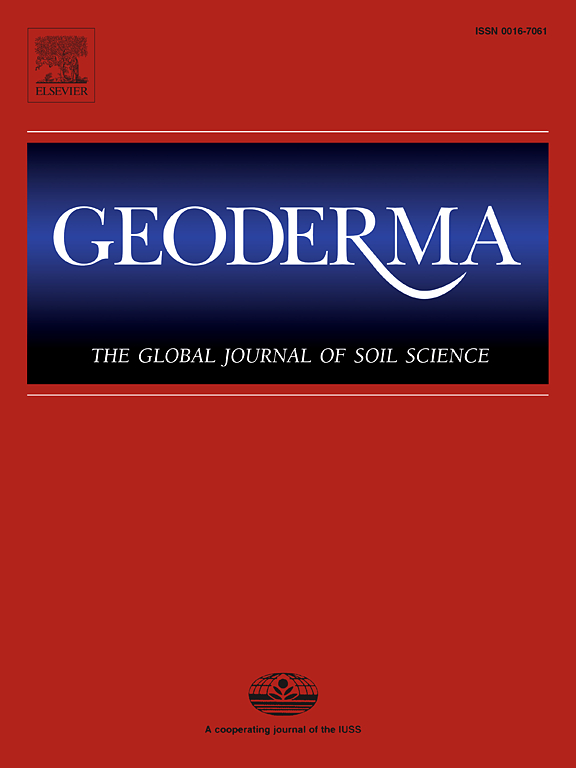The impact of direct and indirect digital soil mapping approaches on spatial uncertainty
IF 6.6
1区 农林科学
Q1 SOIL SCIENCE
引用次数: 0
Abstract
While numerous studies have compared different mapping approaches (or inference trajectories) in digital soil mapping (DSM), their impact on uncertainty quantification and propagation has received less attention. The objective of this study was to investigate key questions related to uncertainty quantification and propagation, which may influence the applicability of DSM products. Including, how do different mapping approaches and assumptions made in DSM affect uncertainty quantification and propagation? What are the pros and cons of the mapping approaches from the perspective of uncertainty? Such questions were examined on the example of mapping soil organic carbon (SOC) in the Great Hungarian Plain, Hungary, by combining machine learning with univariate and multivariate geostatistics. Two cases were investigated: in Case 1, the goal was to map SOC stock for the year 2016 using both direct and indirect mapping approaches and to quantify and compare prediction uncertainty at various spatial aggregation levels. In Case 2, the objective was similar, but focused on mapping SOC stock change between 1992 and 2016. A wide range of inference trajectories (e.g., “calculate then model”, “model then calculate”), prior data transformations (e.g., square root, standard normalization), and uncertainty propagation techniques (e.g., Taylor method, analytical solution) were applied and compared from the perspective of both prediction accuracy (e.g., mean error, root mean square error) and uncertainty (e.g., prediction interval coverage probability plot, interval scores). The results showed that both the chosen inference trajectories and the assumptions made in DSM significantly impact uncertainty estimates not only at point support but also at larger supports. It also highlighted the importance of accounting for the correlation of interpolation errors when conducting uncertainty propagation. Additionally, this research emphasized the need to identify and quantify the contribution of different error sources in uncertainty propagation, as this can be the key to reduce the overall uncertainty associated with the given soil property or function of interest.
直接和间接数字土壤制图方法对空间不确定性的影响
虽然许多研究比较了数字土壤制图(DSM)中不同的制图方法(或推断轨迹),但它们对不确定性量化和传播的影响却很少受到关注。本研究的目的是探讨与不确定性量化和传播相关的关键问题,这些问题可能影响DSM产品的适用性。包括,DSM中不同的映射方法和假设如何影响不确定性的量化和传播?从不确定性的角度来看,映射方法的优缺点是什么?通过将机器学习与单变量和多变量地质统计学相结合,以匈牙利大匈牙利平原土壤有机碳(SOC)制图为例,对这些问题进行了研究。研究了两个案例:案例1的目标是使用直接和间接测绘方法绘制2016年SOC储量图,并量化和比较不同空间聚集水平下的预测不确定性。在案例2中,目标是相似的,但重点是映射1992年至2016年之间SOC库存的变化。从预测精度(如平均误差、均方根误差)和不确定性(如预测区间覆盖概率图、区间分数)的角度比较了广泛的推理轨迹(如“先计算再建模”、“先模型再计算”)、先验数据转换(如平方根、标准归一化)和不确定性传播技术(如泰勒方法、解析解)。结果表明,所选择的推理轨迹和DSM中所做的假设都显著影响不确定性估计,不仅在点支持下,而且在更大的支持下。它还强调了在进行不确定性传播时考虑插值误差相关性的重要性。此外,本研究强调需要识别和量化不确定性传播中不同误差源的贡献,因为这可能是减少与给定土壤性质或感兴趣的函数相关的整体不确定性的关键。
本文章由计算机程序翻译,如有差异,请以英文原文为准。
求助全文
约1分钟内获得全文
求助全文
来源期刊

Geoderma
农林科学-土壤科学
CiteScore
11.80
自引率
6.60%
发文量
597
审稿时长
58 days
期刊介绍:
Geoderma - the global journal of soil science - welcomes authors, readers and soil research from all parts of the world, encourages worldwide soil studies, and embraces all aspects of soil science and its associated pedagogy. The journal particularly welcomes interdisciplinary work focusing on dynamic soil processes and functions across space and time.
 求助内容:
求助内容: 应助结果提醒方式:
应助结果提醒方式:


